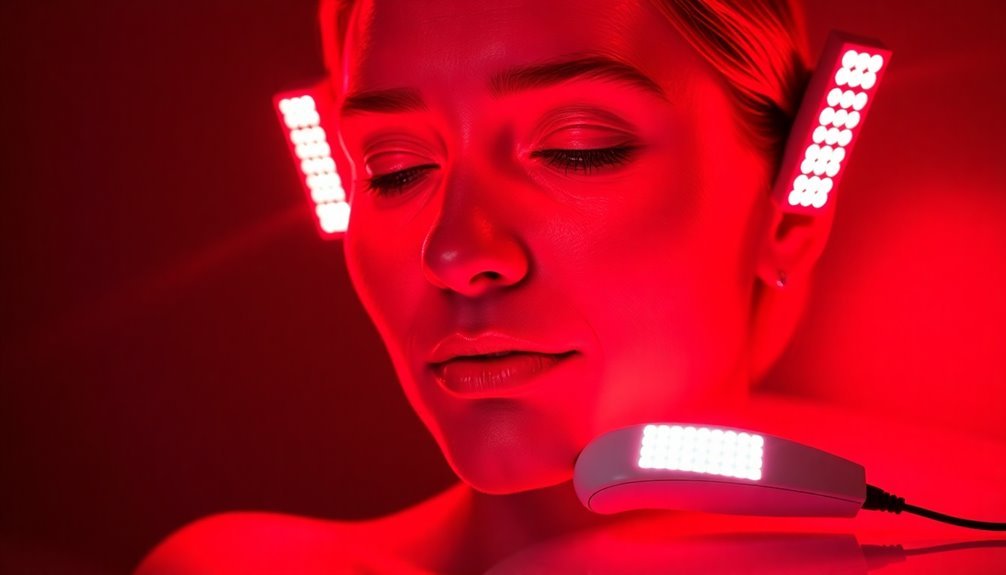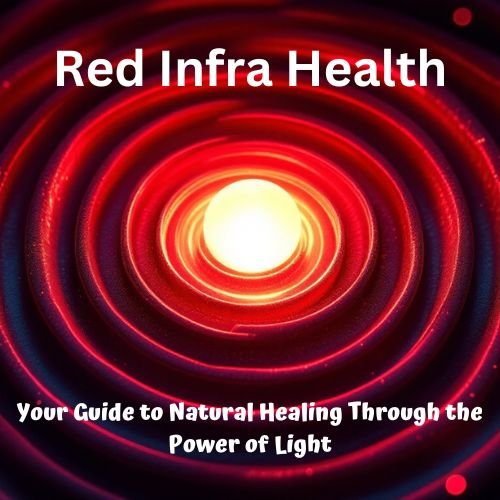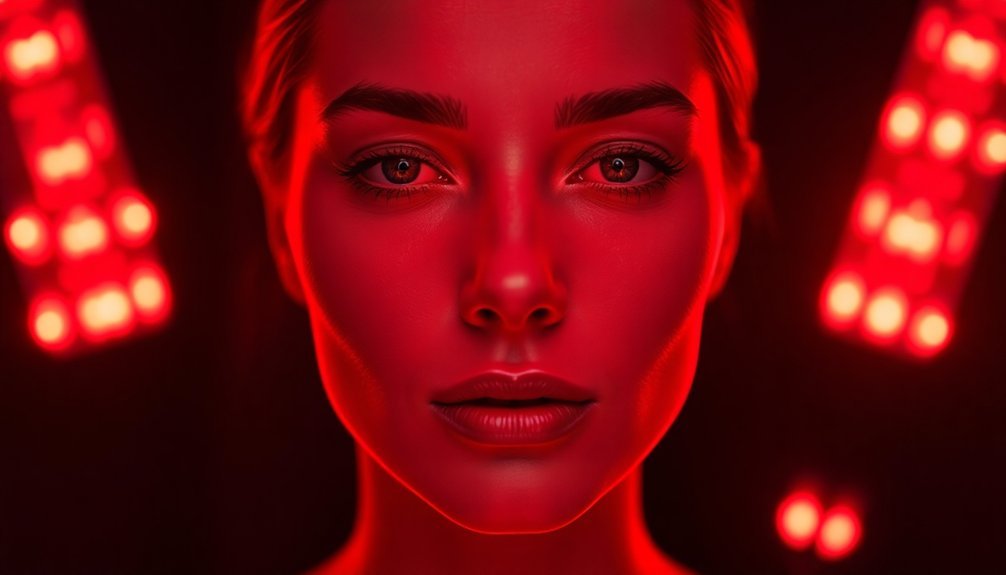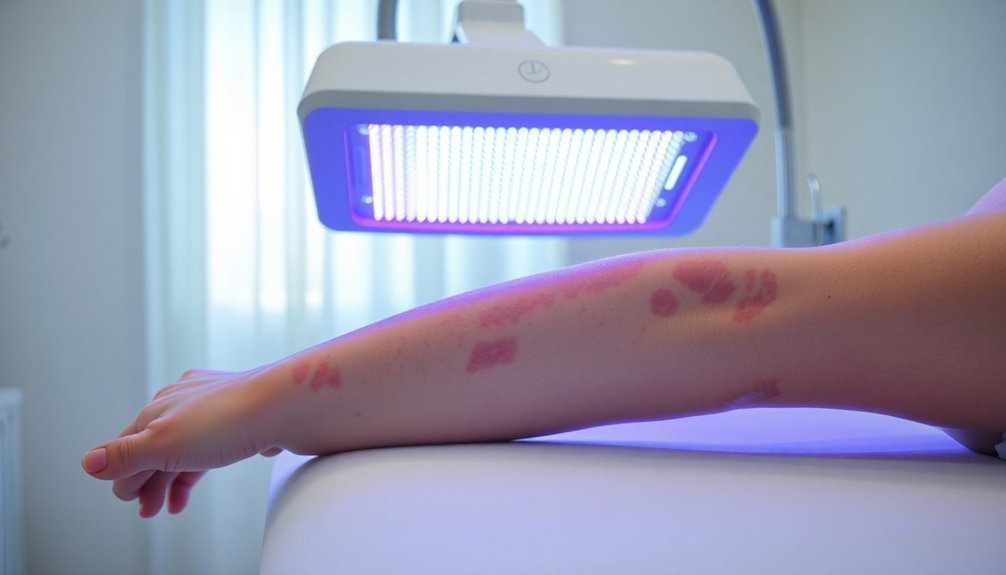LED rays naturally reverse aging by targeting your cells' mitochondria with specific wavelengths of red and near-infrared light. When these rays penetrate your skin, they stimulate ATP production – your cells' energy source – which powers cellular repair and regeneration. This process activates your fibroblasts to produce more collagen and elastin, naturally firming and tightening your skin. You'll see reduced wrinkles, improved texture, and enhanced skin elasticity as the light therapy boosts blood circulation and accelerates cellular turnover. Clinical studies show up to 36% wrinkle reduction, with effects lasting up to 12 weeks. Understanding the science behind these remarkable results will transform how you view anti-aging treatments.
The Science Behind LED Light

Anyone interested in LED light therapy should understand its fundamental mechanism: photobiomodulation. When LED rays penetrate your skin, they interact directly with your cells' mitochondria, triggering a complex series of biological reactions that boost your body's natural rejuvenation process.
At the cellular level, LED therapy works through photoacceptors, particularly cytochrome C oxidase, which absorbs specific wavelengths of light. This interaction kicks off a cascade of events that enhance your cells' energy production by increasing ATP levels. Red light wavelengths of 600-700 nm can deeply penetrate the skin to stimulate these cellular changes.
You'll find that this boost in cellular energy isn't just superficial – it fundamentally improves your cells' ability to function and repair themselves.
The process activates P2Y receptors and initiates purinergic signaling, which facilitates communication between cells. As your cellular metabolism improves, you'll experience reduced oxidative stress and enhanced mitochondrial modulation.
These changes lead to more efficient cellular processes, resulting in visible improvements to your skin's quality.
What makes this therapy particularly appealing is its FDA clearance and proven safety record. You're accessing a scientifically-backed treatment that works with your body's natural processes to achieve lasting rejuvenation effects.
Natural Collagen Production Process
Your skin's natural collagen production starts with fibroblasts, which activate when red and near-infrared LED rays penetrate deep into your tissue layers.
These specialized wavelengths stimulate your fibroblasts to accelerate collagen and elastin synthesis through specific cellular pathways, boosting your skin's structural support system. The treatment safely delivers non-ultraviolet light to rejuvenate your skin without causing damage.
You'll notice improved skin firmness and elasticity as the LED light triggers a cascade of cellular responses, enhancing both collagen production and elastin formation in your deeper skin layers.
Fibroblast Activation Mechanisms
Three essential biological processes drive fibroblast activation, which naturally stimulates collagen production in your skin.
First, when LED light therapy (particularly red and near-infrared wavelengths) penetrates your skin, it triggers growth factors that stimulate your fibroblasts. These activated cells then begin producing more collagen, elastin, and hyaluronic acid – the key components that keep your skin firm and elastic. Research shows these cells utilize multiple signaling pathways to initiate and sustain the collagen production process.
The second process involves cellular turnover, where LED therapy accelerates the replacement of old cells with new, healthy ones.
This rejuvenation process works alongside enhanced blood circulation and improved intercellular metabolism, creating an ideal environment for continued fibroblast activity.
Deep Tissue Light Penetration
Understanding how light penetrates deep tissue layers reveals the fascinating process behind LED therapy's collagen-boosting effects.
When you undergo LED therapy, red light wavelengths between 630 to 700 nanometers penetrate your skin up to 50 millimeters deep, depending on the treatment's intensity and method.
You'll find that red and near-infrared (NIR) light wavelengths work most effectively because they're longer than other light forms, like blue light. These rays stimulate your fibroblasts – the cells responsible for producing collagen – while activating cytokines that enhance cellular communication and repair.
Your skin's firmness and elasticity improve as collagen production increases. Melanin levels in your skin can affect treatment efficacy since higher melanin content reduces the penetration of light waves.
What's particularly remarkable is how the light's effects extend beyond the treatment area. Even though the light intensity decreases as it travels deeper into your tissue, you'll still experience photobiomodulation benefits below the surface.
The process involves the 1D transport factor, which accounts for how light beams penetrate homogeneous tissue while considering backscatter effects. While continuous irradiation at 633 nanometers effectively modulates collagen synthesis, it's crucial to observe that results can vary based on your skin type and condition.
Elastin Synthesis Pathways
The intricate process of elastin synthesis begins deep within your skin cells, working alongside collagen production to maintain skin elasticity. Your cells start by activating the ELN gene, which triggers the creation of tropoelastin in the endoplasmic reticulum. Special proteins called chaperones, like BIP and FKBP65, help fold this tropoelastin correctly before it's transported to the cell surface. As with Type I and III collagen, these proteins form essential structural components that give skin its resilient properties.
| Process Stage | What's Happening |
|---|---|
| Initiation | ELN gene activates, producing tropoelastin |
| Folding | Chaperone proteins assist with proper structure |
| Transport | Tropoelastin moves to cell surface |
| Assembly | Proteins align on microfibril scaffold |
| Cross-linking | LOX enzyme creates stable elastic fibers |
Your skin's elastin production is carefully regulated by various molecules. While MMPs can break down elastin, TIMPs work to protect it. Growth factors like TGFβ1 help maintain healthy elastin levels by suppressing breakdown processes. When combined with collagen, these elastic fibers create a resilient network that helps your skin bounce back after stretching. This natural process is essential for maintaining youthful, firm skin and can be supported through proper skincare and protection from environmental damage.
Deep Tissue Penetration Benefits

Light's remarkable journey through human tissue holds the key to understanding LED therapy's effectiveness in reverse aging. When specific wavelengths of LED light penetrate your skin, they interact with chromophores in your cells, triggering a cascade of beneficial reactions that combat aging signs.
You'll find that different wavelengths serve distinct purposes in your anti-aging journey. Red light, penetrating 0.5 to 1 mm deep, stimulates your skin's fibroblasts to produce more collagen, effectively reducing wrinkles and improving skin firmness. This therapy effectively addresses sun damage through consistent treatments.
Near-infrared light reaches even deeper tissues, enhancing cellular function through increased ATP production in your mitochondria.
While LED therapy isn't as powerful as laser treatments, it's particularly effective for treating larger areas of aging skin. When you're exposed to LED therapy, the light energy triggers your cells to work more efficiently, boosting natural healing processes.
You'll notice improvements in skin texture, reduced inflammation, and enhanced tissue repair.
Your skin particularly benefits from the combination of wavelengths. Blue light tackles surface concerns like bacteria, while red and near-infrared lights work beneath the surface to stimulate collagen production and cellular regeneration, giving you thorough anti-aging results.
Aging Reversal Mechanism
Deep within your cells, LED light therapy sets off a remarkable chain of biological events that directly combat aging. The process begins with increased production of ATP, your cells' energy currency, which powers cellular rejuvenation and repair.
As LED rays penetrate your skin, they stimulate the production of essential proteins like collagen and elastin, which are responsible for maintaining your skin's firmness and elasticity. This technology, which originated from NASA's plant research, has revolutionized modern skincare approaches.
You'll benefit from enhanced cellular turnover as LED therapy accelerates the replacement of damaged skin cells with healthy new ones. The treatment boosts circulation, allowing for better nutrient delivery and waste removal at the cellular level.
Your mitochondria – the powerhouses of your cells – become more efficient, supporting overall cellular health and function.
Research confirms these mechanisms, with studies showing significant improvements in skin elasticity and firmness after LED treatment. The therapy works through both single and interval irradiation patterns, with different wavelengths working synergistically to amplify results.
Since it's non-invasive and suitable for all skin types, you can safely incorporate LED therapy into your anti-aging routine without worrying about adverse effects.
Cellular Regeneration Effects

Your cells experience a remarkable boost in mitochondrial energy production when exposed to specific LED wavelengths, particularly in the red and near-infrared spectrum.
These therapeutic rays trigger deep tissue repair mechanisms by stimulating ATP production and regulating reactive oxygen species at the cellular level.
The process activates dormant fibroblasts, which then accelerate the production of collagen and elastin, leading to enhanced cellular regeneration and tissue repair. This regenerative activity is enhanced through cytochrome C oxidase, which plays a crucial role in oxidative metabolism and electron transport.
Mitochondrial Energy Production Boost
Living cells experience a remarkable transformation when exposed to LED therapy, particularly through its effects on mitochondrial function and cellular regeneration.
Your cells' mitochondria, often called the powerhouses, receive a significant boost as LED rays stimulate and activate their energy production capabilities. This activation enhances your body's natural ATP synthesis and triggers mitochondrial biogenesis, creating new energy factories within your cells.
When you undergo LED therapy, the light energy, especially in the red spectrum, works through specific photoacceptors like cytochrome C oxidase and membrane ion channels. This interaction optimizes your cellular respiration and reduces oxidative stress, leading to more efficient energy production. The therapy utilizes UV-free light waves that ensure complete safety for your skin's surface.
You'll find that high-quality LED lighting with high CRI and low CCT particularly enhances these mitochondrial functions.
The boost in mitochondrial energy production directly supports your body's cellular regeneration processes. As your cells receive more energy, they're better equipped to replace damaged cells with healthy ones.
This increased cellular turnover leads to improved skin elasticity, reduced fine lines, and enhanced overall tissue health, effectively supporting your body's natural anti-aging mechanisms.
Deep Tissue Repair Mechanisms
Cell repair powerhouses spring into action when LED light penetrates deep into your tissues, triggering a cascade of regenerative processes. Your cells' photoacceptors, particularly cytochrome C oxidase, absorb the light energy and convert it into increased ATP production. This boost in cellular energy drives faster tissue repair and regeneration, while simultaneously reducing inflammation that can slow down healing. LED therapy ensures painless treatment delivery while promoting optimal healing conditions.
The deep tissue repair doesn't stop there. Your skin's natural collagen production gets a significant boost, while specialized cells called keratinocytes begin migrating to areas that need repair. You'll notice enhanced blood flow to damaged tissues, delivering essential nutrients and oxygen where they're needed most.
- Experience the satisfaction of watching your skin become firmer and more resilient as new collagen forms beneath the surface
- Feel renewed confidence as stubborn scars begin to fade through enhanced tissue regeneration
- Enjoy the comfort of natural healing without invasive procedures or downtime
Through this cellular revival, your skin's repair mechanisms work more efficiently, promoting smoother, healthier-looking tissue. The combination of increased ATP, cytokine production, and enhanced blood flow creates a crucial environment for your body's natural healing processes to thrive.
Fibroblast Activation Process
Deep within the body's healing symphony, fibroblasts take center stage as powerful cellular regenerators when exposed to LED light therapy. When specific wavelengths of LED light hit your skin, they trigger a cascade of cellular responses that activate your fibroblasts to produce more collagen and accelerate healing.
Your skin's fibroblasts respond differently to various wavelengths. While green light maximizes cell proliferation, dual-wavelength therapy (635 nm + 830 nm) offers the best results for wound healing and collagen synthesis. The light interacts with photoacceptors in your cells, particularly cytochrome C oxidase, leading to enhanced mitochondrial function and controlled ROS production.
| Wavelength | Primary Effect | Clinical Benefit |
|---|---|---|
| Green | Highest proliferation | Enhanced cell growth |
| Red (635nm) | Collagen synthesis | Skin firmness |
| Infrared (830nm) | Deep penetration | Tissue repair |
| Dual (635+830nm) | Combined action | Best healing |
| Blue (450nm) | Surface treatment | Bacterial control |
You'll find that LED therapy's ability to stimulate fibroblasts makes it particularly effective for skin regeneration. This natural activation process works through your body's own healing mechanisms, making it both safe and sustainable for long-term use.
Skin Elasticity Enhancement
Three key mechanisms drive LED therapy's remarkable effects on skin elasticity. When specific wavelengths penetrate your skin, they trigger cellular stimulation, enhancing ATP production and activating essential compounds like ROS and nitric oxide. This cellular awakening leads to improved collagen synthesis and enhanced skin firmness.
Your skin's natural elasticity gets a significant boost through increased collagen density and elastin production. Studies show that LED treatments can boost type-1 procollagen levels by 31% while reducing MMP-1 levels by 18%, resulting in firmer, more resilient skin.
- You'll experience visibly smoother skin texture as LED rays work at the molecular level to rejuvenate aging cells
- Your skin will feel naturally firmer as collagen fibers strengthen and multiply
- You'll notice a youthful bounce return to your complexion through enhanced elastin production
The most effective results come from specific wavelengths, particularly in the 630-700nm range. Red light at 660nm proves especially powerful for collagen production, while combining different wavelengths can maximize benefits.
Best of all, this scientifically-proven method delivers these remarkable results without adverse effects or downtime, making it a safe, reliable choice for skin rejuvenation.
Clinical Evidence and Research

Compelling research demonstrates LED therapy's effectiveness through extensive clinical trials and laboratory studies. Scientific findings show that LED treatments can reduce wrinkles by up to 36% while substantially increasing collagen and elastic fibers in treated skin areas.
LED therapy at 660nm wavelength specifically stimulates collagen synthesis and transforms fibroblasts into myofibroblasts, essential for skin rejuvenation.
Clinical studies reveal that LED therapy protects your skin against UV damage, functioning similarly to SPF-15 sunscreen. You'll benefit from the treatment's anti-inflammatory properties, as it increases TIMP-1 and TIMP-2 while reducing IL-6 levels. Research also confirms LED's effectiveness in regulating collagen metabolism by reducing MMP expression.
When comparing technologies, studies show that both LED and OLED treatments effectively upregulate collagen production, though OLED demonstrates superior results in human dermal fibroblasts.
You'll see thorough evidence supporting LED therapy's versatility in treating various skin concerns, from acne to aging. The treatment's safety and efficacy are well-documented through both in vitro and in vivo studies, confirming its value in non-ablative skin treatments.
Treatment Duration and Results
Building on these research findings, achieving ideal results with LED therapy requires a structured treatment schedule. You'll need to commit to nine 20-minute sessions, with treatments spaced strategically over several weeks. This proven approach has demonstrated up to 36% reduction in wrinkles and a 19% increase in skin elasticity.
The transformative effects of LED therapy become more pronounced as you progress through your treatment journey. By combining different wavelengths, particularly 633 and 830 nm, you'll experience enhanced results that can last up to 12 weeks post-treatment.
Clinical studies show that 97.4% of participants noticed significant improvements in their skin's appearance.
- Feel the excitement as your skin's natural collagen production increases, revealing a more youthful appearance with each session
- Experience the confidence boost as wrinkles and fine lines gradually diminish, reflecting a younger-looking you
- Embrace the satisfaction of choosing a non-invasive treatment that delivers lasting results without downtime
For the best outcomes, you can amplify your results by incorporating complementary treatments like green tea serum. The key is consistency in following the treatment schedule while maintaining realistic expectations for gradual, natural-looking improvements.
At-Home LED Application Methods

Successful at-home LED therapy starts with proper preparation and technique. You'll need to begin with a double cleanse – first using a basic cleanser to remove makeup, followed by a skin-type-specific cleanser for deeper cleaning.
Apply round cotton eye pads or manufacturer-recommended eye protection, then use a light enzyme mask with steam for 10 minutes.
After removing the mask, apply your LED-compatible serum according to the manufacturer's guidelines. Position the device panel about an inch from your face, following the specific protocol for your device.
You'll want to maintain the treatment for at least 15 minutes, though 30 minutes typically yields better results. If you're using a handheld device, spend at least 5 minutes on each facial zone.
Complete your treatment by applying appropriate serums like vitamin C or hyaluronic acid if you haven't already done so. Follow with moisturizer and sunscreen for protection.
Remember to strictly follow your device's instructions regarding program settings, distance, and treatment duration. While LED therapy is generally safe, you'll need to be cautious if you have light sensitivity and always use FDA-approved devices to guarantee your safety.
Frequently Asked Questions
Can LED Light Therapy Interfere With Prescription Medications or Skin Products?
You won't experience interference between LED light therapy and most medications. However, you should remove sunscreen before treatment, and you'll get better results using products like vitamin C and retinol afterward.
Is LED Therapy Safe During Pregnancy or While Breastfeeding?
You should consult your healthcare provider before using LED therapy during pregnancy or breastfeeding. While it's potentially safe with precautions, there's limited research, so it's best to get professional guidance for your specific situation.
How Does Skin Color Affect LED Light Therapy Results?
Your skin's melanin content affects LED therapy effectiveness. If you have darker skin, you'll need longer sessions as melanin absorbs more light. Fair skin typically responds better, requiring shorter treatments for the best results.
Can LED Therapy Worsen Existing Skin Conditions Like Rosacea?
While LED therapy is generally safe for rosacea, you'll want to start cautiously as it can temporarily worsen symptoms if not used correctly. Always consult a dermatologist and use appropriate wavelengths for your condition.
Does LED Therapy Work Differently on Different Body Parts?
Yes, LED therapy's effectiveness varies by body part due to skin thickness and condition types. You'll notice different results treating facial concerns versus body acne or psoriasis patches on your arms or back.
In Summary
You've learned how LED light therapy naturally reverses aging through wavelength-specific treatments that boost collagen production and cellular repair. By incorporating regular LED sessions into your skincare routine, you'll notice improved elasticity, reduced wrinkles, and rejuvenated skin. Remember to follow recommended treatment times and maintain consistency. While results vary, you can expect visible improvements within 8-12 weeks of proper LED light therapy use.





Leave a Reply